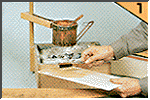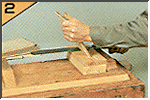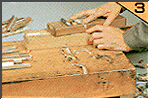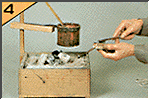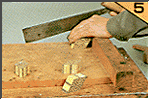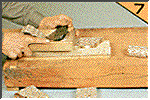Manufacture Process of "Yosegi-Zaiku"
寄木細工制作工程
箱根の名品 寄木細工についてご説明いたします。
 Skillful Craftsmen of Hakone Hakone-Zaiku Marquetry
Skillful Craftsmen of Hakone Hakone-Zaiku Marquetry Hakone-Zaiku Marquetry was first created in the early Heian Period. During the Edo Period it thrived as secondary jobs for many "Kagokaki", and started being sold at "Chaya"(tea shops).
There are two types of Hakone-Zaiku Marquetry, "Hikimono" and "Sashimono".
Hakone-Zaiku Marquetry was first created in the early Heian Period. During the Edo Period it thrived as secondary jobs for many "Kagokaki", and started being sold at "Chaya"(tea shops).
There are two types of Hakone-Zaiku Marquetry, "Hikimono" and "Sashimono"."Hikimono", produced using potter's wheels includes various products including bowls, and since the Edo Period Hikimono toys have been produced. "Sashimono", mainly boxes, are decorated on the surfaces with "Yosegi-Zaiku Marquetry" or "Zougan-Zaiku Wooden Mosaic".
"Yosegi-Zaiku Marquetry" is carried out according to the following process; first timbers with natural colors are collected (and sometimes colored), then they are shaved with a plane (the thin shaved tree is called juku) and made into mosaic-pattern trees. Finally the thin paper-like trees are stuck on craftwork.
"Zougan-Zaiku" is made by the following process; timbers in various colors are set in a board, making the board look like a picture. This is also called Mokukga. Like in "Yosegi-Zaiku Marquetry", or thin paper like tree craft ("Zuku"), they are stuck on craftwork.
 箱根職人の心技 伝統工芸箱根細工
箱根職人の心技 伝統工芸箱根細工箱根細工には「挽物」(ひきもの)と「指物」(さしもの)のがあります。
「挽物」はろくろを使用して作られる品物で、盆、椀、丸膳などがあり、明治以後は多くの玩具類も製作されています。
「指物」は主に箱類で、その表面を「寄木細工」や「象嵌(ぞうがん)細工」で装飾します。
 Hakone-Yosegi-Zaiku Marquetry
Hakone-Yosegi-Zaiku Marquetry The mountains of Hakone are noted for the numerous varieties of trees found along their slopes.
The mountains of Hakone are noted for the numerous varieties of trees found along their slopes.Hakone-Yosegi-Zaiku marquetry is a from of inlaid and mosaic woodwork unique to this area, and craftsmen have made full use of the wealth of wood colors and textures found here to produce their elaborate geometric patterns. Hakone-Yosegi-Zaiku decorates small hand-crafted items such as trays, boxes and chests.
 This marquetry technique was created in the late Edo Period by a local master craftsman, Nihei Ishikawa (1790-1850), who lived in the Hatajuku area of Hakone.
This marquetry technique was created in the late Edo Period by a local master craftsman, Nihei Ishikawa (1790-1850), who lived in the Hatajuku area of Hakone.In May,1984, Hakone-Yosegi-Zaiku was designated a national traditional handicraft by the International Trade & Industry Minister.
Main Wood for Hakone-Yosegi-Zaiku
White : aohada(Ilex macropoda Miq.),spindle tree, dogwood
Yellow : nigaki(Picrasma quassioides Benn.), wax tree,lacquer tree
Light Brown : Japanese pagoda tree,cherry tree,zelkova tree
Dark Brown : keyaki-jindai
Gray : honoki(Magnolia hypoleuca)
Black : katsura-jindai
なお、箱根寄木細工は昭和59年5月に国の伝統的工芸品として通商産業大臣の指定を受けました。
箱根寄木細工の主な用材
白色系:あおはだ、まゆみ、みずき
黄色系:にがき、はぜの木、うるし
茶色系:えんじゆ、さくら、けやき
褐色系:けやき神代
灰色系:ほおのき
黒色系:かつら神代
 How Hakone-Yosegi-Zaiku Is Made 箱根寄木細工のできるまで
How Hakone-Yosegi-Zaiku Is Made 箱根寄木細工のできるまで